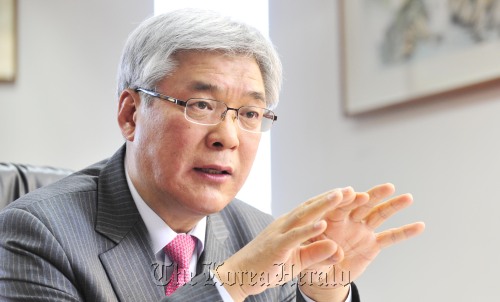Head of emergency management agency calls for more support for firefighters
Korea is now an emerging leader in international disaster response after previously being largely disregarded in the field, said the state’s emergency agency chief.
The National Emergency Management Agency’s Korean Disaster Relief Team has come a long way since its international debut in 1997 and is now only one of a handful of teams deemed ready to enter any rescue situation.
“We are the 16th nation to have a rescue team classified as “heavy.” Receiving that might be our team’s biggest achievement last year,” NEMA Administrator Li Ki-hwan told The Korea Herald.
He was referring to his unit’s classification last November as a Heavy Urban Search and Rescue Team by the United Nations Office for the Coordination of Humanitarian Affairs.
This puts Korea alongside countries such as Russia, the U.K. and the U.S., and is one of four Asian countries to receive the classification.
According to the UN OCHA, heavy rescue teams work in difficult and complex technical search and rescue operations under the guidance of the International Search and Rescue Advisory Group.
And according to Li, NEMA is hoping this opportunity places Korea firmly on the global map leading the way for further cooperation and support to and from the international emergency responder community.
The rescue unit made its international debut in a 1997 plane crash in Cambodia. Since then, it has been deployed 15 times to overseas emergency relief missions.
In the wake of Japan’s devastating earthquake and tsunami in March 2011, Korea sent more responders than the U.S., U.K. and Germany, and was one of the last to pull out despite the nuclear reactor crisis that followed.
“We went to Japan, but we were not allowed to approach sites that potentially had survivors, (because we were not ‘heavy-rescue unit at that time).”
“Now we can act in areas regardless of whether survivors may or may not be there without any logistical interference,” Li said.
 |
National Emergency Management Agency Administrator Li Ki-hwan talks about Korea’s role in international search and rescue at his office in Seoul. (Kim Myung-sub/The Korea Herald) |
NEMA was established in 2004 to increase the nation’s disaster preparedness and coordinate its response once a disaster strikes.
Li, a lifelong firefighter who became the agency’s chief in July 2011, stressed that preventative measures are just as important as a quick and efficient response afterwards.
“We are currently pushing to survey areas throughout the nation that are particularly exposed to disaster,” he said.
NEMA has also boosted its disaster prevention budget, skyrocketing from 398 billion won ($354 million) in 2008 to 1.19 trillion won in 2012.
More than half of 2012’s budget, or 633.7 billion won, will go into reinforcing preventative work in areas deemed high risk of being damaged by natural disasters, the official said.
In 2011, NEMA was able to reduce the amount of damage caused by landslides and floods from torrential downpours from 1.495 trillion won worth in 2001 to 747.7 billion won in 2010.
Despite many improvements and the global recognition, however, the country could still do a lot more to protect emergency rescuers and firefighters who risk their lives to save others, Li stressed.
A recent report by the agency shows that 17.3 percent of the equipment that firefighters use is outdated, putting their lives at risk in an unforgiving occupation.
“When I went to visit injured firefighters after they were engulfed by a backdraft in South Gyeongsang Province, a mother brought me to tears when she told me her son’s gloves had melted onto his skin.”
“The problem is that fire departments in rural areas and districts need funds to replace equipment but there is a limit to how much they can provide the departments,” said Li.
The data released Thursday also showed that roughly 7 percent of firefighters had their own fire-retardant bunker gear and over 21 percent had their own boots.
More than 19 percent of all fire trucks in NEMA’s fleets are outdated, also endangering the lives of firefighters.
In January last year, a Gwangju firefighter fell to his death from a faulty fire engine ladder while attempting to remove icicles.
“The burden of financial support should fall on the central government,” said Li.
By Robert Lee (
robert@heraldcorp.com)








